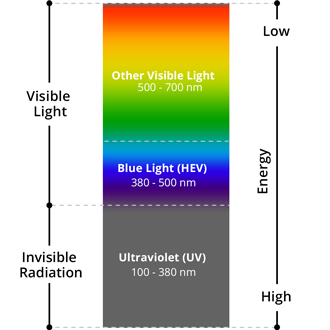Blue light is a range of the visible light spectrum, defined as having a wavelength between 400−495 nm.

This short wavelength means that blue light is a type of high-energy visible (HEV) light, defined as having a wavelength between 400 and 450 nm.
Blue light sources are becoming increasingly common in today's environment.
Exposure to blue light comes from a variety of technologies including computers, televisions, and lights.
Much of the exposure arises from light emitting diodes (LEDs).
While improving work efficiency and enjoying entertainment, you should also notice that your eyes are being hurt by Blue Light.
In 1966, studies found that exposure to blue light can cause damage to retinal cells, leading to decreased or even lost vision.
Among them, short-wave blue light with a wavelength between 400-450 nm has the greatest damage to the retina.
The blue light in this wavelength will increase the amount of toxin in the macular area of the eye, which seriously threatens the health of our fundus. Blu-ray-induced blind eye disease, the current effective solution is to film the film. The anti-blue film technology is very mature and low in cost, which can effectively prevent blue light from penetrating.
But blue light is not all harmful, what is really harmful is blue light within 400 to 450nanometers.
And blue light between 480 and 500 nanometers has a function of adjusting biological rhythm, sleep, mood, memory, etc, which is beneficial to the human body.
Moreover, short-wave blue light harm to the human eye, which is related to the irradiation intensity and the irradiation time. When the illumination reaches a certain level, it lasts for more than two hours, and it is possible to damage the retina.
The harm of blue light to the human eye is mainly in 3 aspects below:
1- Damage eyes.
Harmful blue light has extremely high energy and can penetrate the lens to reach the retina, causing atrophy or even death of retinal pigment epithelial cells.
The death of light-sensitive cells will result in decreased or even complete loss of vision, which is irreversible.
Blue light can also cause macular degeneration. The crystals in the human eye absorb some of the blue light and gradually become turbid to form a cataract. Most of the blue light will penetrate the crystals. Especially the children's crystals are clear and cannot effectively resist blue light, which is more likely to cause macular degeneration and cataract.
2- Visual fatigue.
Since the wavelength of the blue light is short, the focus point does not fall at the center of the retina, but is located a little further forward from the retina.
To see clearly, the eyeball will be in a state of tension for a long time, causing visual fatigue. Long-term visual fatigue may lead to deeper myopia, double vision, easy serialization during reading, and inability to concentrate, which affects people's learning and work efficiency.
3- Affect sleeping.
Blue light inhibits the secretion of melatonin, an important hormone that affects sleep. The currently known role is to promote sleep and regulate jet lag.
This also explains why playing a mobile phone or tablet before going to bed can cause poor sleep quality or even difficulty falling asleep.
Since short-wavelength light has a relatively high energy, the incidence of fine particles in the air is high, which is the main cause of glare.
Patients with retinopathy and post-operative surgery (excimer surgery, cataract surgery) are very sensitive to light and can feel abnormal glare, which is also caused by short-wave blue light.
But, Not all Blue Light is Bad.
It's well documented that some blue light exposure is essential for good health.
Research has shown that high-energy visible light boosts alertness, helps memory and cognitive function and elevates mood.
In fact, something called light therapy is used to treat seasonal affective disorder (SAD) — a type of depression that's related to changes in seasons, with symptoms usually beginning in the fall and continuing through winter.
The light sources for this therapy emit bright white light that contains a significant amount of HEV blue light rays.
Also, blue light is very important in regulating circadian rhythm — the body's natural wakefulness and sleep cycle.
Exposure to blue light during daytime hours helps maintain a healthful circadian rhythm.
For more info about Blue Light, please contact LPO!
Reference:

